|
|
|
Sort Order |
|
|
|
Items / Page
|
|
|
|
|
|
|
| Srl | Item |
| 1 |
ID:
076564
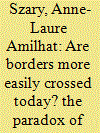

|
|
|
| 2 |
ID:
157791
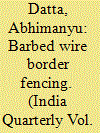

|
|
|
|
|
| Summary/Abstract |
The Government of India decided to fence the entire India–Bangladesh border to prevent the illegal immigration from Bangladesh and to prevent the cross-border illegal and antisocial activities. Since the year 1986, the Government of India started the initiative to construct the border fencing in phase manner. The single wire border fencing which was created in the first phase has been replaced by the composite type of barbed wire border fencing a few years ago. Now the border fencing along the international border between India and Bangladesh has become a structural barrier for the Indian families living at the Country’s territorial edge. The families trapped in the geographical space between actual line of partition and the border fencing are living a restricted and deprived life within the limited land.
This study is basically focused on the impact of the border fencing on the citizenship rights of the Indian fenced out families. This article will discuss how the defensive policies of the Government are affecting the citizen’s rights at the border regions of the country and subsequently resulting in displacement.
|
|
|
|
|
|
|
|
|
|
|
|
|
|
|
|
| 3 |
ID:
145546


|
|
|
|
|
| Publication |
New Delhi, Adroit Publishers, 2016.
|
| Description |
xvii, 377p.: table, figurehbk
|
| Standard Number |
9788187393085
|
|
|
|
|
|
|
|
|
|
|
|
Copies: C:1/I:0,R:0,Q:0
Circulation
| Accession# | Call# | Current Location | Status | Policy | Location |
| 058694 | 954.5498/KHA 058694 | Main | On Shelf | General | |
|
|
|
|
| 4 |
ID:
123711
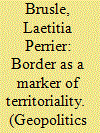

|
|
|
|
|
| Publication |
2013.
|
| Summary/Abstract |
This paper considers the film Frozen River (2008) for the purpose of considering how the US-Canadian border is dramatised within the context of two women caught up in a illicit trading of migrants via a Native American Reservation. Re-calibrating more mainstream Hollywood's fascination with the United States' southern border, Frozen River usefully focuses attention on two areas that deserve further reflection namely the materiality of borders and border crossings and biopolitics. The paper concludes with some reflections on how borders, biopolitics, dispossession and sovereignty need further theorization by political geographers and other scholars.
|
|
|
|
|
|
|
|
|
|
|
|
|
|
|
|
| 5 |
ID:
167160
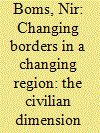

|
|
|
|
|
| Summary/Abstract |
The Syrian civil war – which has largely ended following bloody 8 years – serves as a prime case study of mechanisms which challenge border realities, as well as geography and demography, through engagement of manifold internal and external actors. This article discusses these processes and their implications by focusing on the Syro-Israeli borderland. It analyses the main actors and their motives, geography of interactions, as well as implications for humanitarian situation and security considerations. It is argued that while the dynamics in the Syro-Israeli borderland have several unique characteristics, they also point to a broader process of re-drawing borderlands and lines of influence in the Middle East region.
|
|
|
|
|
|
|
|
|
|
|
|
|
|
|
|
| 6 |
ID:
098115
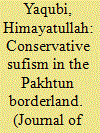

|
|
|
| 7 |
ID:
147660
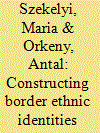

|
|
|
|
|
| Summary/Abstract |
The analysis is based on an empirical sociological study (interplay of European, National and Regional Identities: nations between states along the new eastern borders of the European Union Project) aimed at exploring the various aspects of people’s diaspora affiliations and their ethnic and national identity on the Eastern borderland of Europe. We surveyed ethnic minority groups in eight countries along the frontier of Central Eastern Europe. With the ethnic minorities having a similar ethnic status along the border, we demonstrated how ethnic minorities ‘deal’ with their minority status in their ‘host’ country. The analysis reconstructs the image of the ethnic minority at the societal level. We model personal and collective ethnic identities as a stock of knowledge based on cognitive and affective components, and test them along the different ethnic dyads. The paper shows how successive generations are able to transfer the pattern of ethnic identity within the family, and also how language use practices and personal networks play a role in preserving personal ethnic identity.
|
|
|
|
|
|
|
|
|
|
|
|
|
|
|
|
| 8 |
ID:
157501
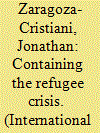

|
|
|
|
|
| Summary/Abstract |
The events that took place during the 2015-16 refugee crisis in the southeastern EU region boosted unprecedented bordering processes. Borders were reinforced and extended and a costly and difficult deal with Turkey was undertaken; the western Balkans were turned into a vast buffer zone made up of multiple buffer states with fences of all types and sizes; while Greece was ring-fenced and to this day struggles to manage thousands of refugees stranded in camps all over its territory. By seeking to contain the refugee flows, the EU turned its southeastern region into a fortified EU borderland.
|
|
|
|
|
|
|
|
|
|
|
|
|
|
|
|
| 9 |
ID:
182576


|
|
|
|
|
| Summary/Abstract |
Borderland areas separating the state of Sarawak (Malaysia) and West Kalimantan (Indonesia) have long been a security concern for the Sarawak State Government. In general, such areas emerge as cross-border crime scenes, where many cases are constantly reported to the relevant security authorities. Despite the perseverance of Malaysia in enhancing border security, particularly that of the Sarawak state government, a discourse centred on state-centric security on people’s security issues in the affected area remains lacking. Border communities are rarely asked about matters of personal safety which can shed some light on the depiction of borderlands as insecure regions threatening human security. Although calls to secure national borders are evident, the perspectives of border communities are often discounted. This paper aims to highlight the importance of an empirical study in understanding human security from a spatial context of a borderland. By analysing the perceptions of people residing close to the border, this study contextualises human (in)security focusing on border community narratives and experiences and reflects on how borders impact people’s daily life. The analysis thematically underlined the value of including people’s collective experiences gathered through focus group discussions (FGDs) among the border communities of Danau Melikin, Serian, Sarawak. The findings offered insights into the population’s mental state and contributed to the current understanding of human (in)security from a bottom-up perspective. Accordingly, the study reported that people’s perception of threats and fear resulted from cross-border threats, where the profound effects related to human security threats were mostly influenced by border vulnerabilities. In this vein, the border as a ‘space’ was essential in influencing insecurity among the border communities of Danau Melikin, Serian.
|
|
|
|
|
|
|
|
|
|
|
|
|
|
|
|
| 10 |
ID:
186316
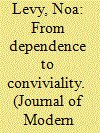

|
|
|
|
|
| Summary/Abstract |
Unaccompanied child and youth migrants negotiate with local host communities in their attempts to find a place to belong to, yet research has generally neglected their participation in the making of relationships with the people around them. Providing a perspective of the longue durée, the Zimbabwean–South African borderland teaches us that time is critical in young migrants’ ability to negotiate their positioning and actively shape relationships with host communities, based on mutual interest. While at the beginning of their stay, unaccompanied children and youth were at the mercy of others, time enabled them to accumulate knowledge and develop skills that were in demand, shifting their place in society and setting the ground for conviviality.
|
|
|
|
|
|
|
|
|
|
|
|
|
|
|
|
| 11 |
ID:
190953


|
|
|
|
|
| Summary/Abstract |
One of the epic national narratives of modernization and development in China is the story of Beidahuang (‘Great Northern Wilderness’) in the country’s northeast. The term ‘Beidahuang’ refers originally to state-sponsored campaigns, starting in the 1950s, that involved the enlistment of tens of thousands of People’s Liberation Army soldiers, educated youth, and Communist Party cadres. Their task was to transform the vast northeast ‘wasteland’ into productive farmland that would feed the nation while securing the nation’s borders with Russia. This article examines the significance of Beidahuang as a feature of the environmental discourse in China’s northeast borderlands, focusing on the first decade of the twenty-first century when the Chinese state was establishing more systematic measures for addressing environmental concerns. In the context of the northeast borderland, the massive deforestation that resulted from the socialist campaigns to transform ‘wasteland’ into productive farmland has left a controversial legacy for regional elites grappling with the Party leadership’s turn towards environmental conservation as an emerging political priority. This article suggests that the ongoing importance of the ‘Great Northern Wilderness’ in the Chinese cultural imagination has shaped the ways in which regional elites frame environmental issues in relation to economic development, nationalism, and border relations with Russia.
|
|
|
|
|
|
|
|
|
|
|
|
|
|
|
|
| 12 |
ID:
147460
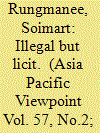

|
|
|
|
|
| Summary/Abstract |
Based on research in a border village in Northeast Thailand and two villages in Laos, this paper discusses how formal regulations on cross-border migration are negotiated, such that the practice becomes socially acceptable amongst receiving communities. This paper focuses on the border-crossing experiences of Lao migrants to argue that regulations governing the Thai–Lao borders have been circumvented in response to labour demands in the Thai borderlands and mutual interest between local state officials and borderlanders. It is illegal for undocumented migrants to cross the Mekong to work in the farms along the Northeast Thai–Lao borderlands, but the practice has become socially acceptable. This licit1 status helps Lao migrants to navigate local state authorities, who are also involved in local social relations.The importance of local social relations is emphasised by differences in cross border-migration between jobs in agriculture and jobs in service industries. In urban settings, migrants do not participate in local social relations to the same extent. Consequently, they are viewed as illicit2, as well as illegal. While acknowledging the ongoing legal constraints on migrants and their movements, this paper seeks to provide an understanding of how state authority in the border regions is mediated by enduring social relations that create a legitimate space for informal and mutually beneficial actions.
|
|
|
|
|
|
|
|
|
|
|
|
|
|
|
|
| 13 |
ID:
192861
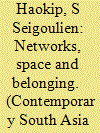

|
|
|
|
|
| Summary/Abstract |
This article aims to supplement existing economic analyses of the Marwari mercantile network by exploring how the network is both grounded spatially and reproduced culturally in Manipur. It discusses some of the economic and socio-cultural practices adopted by the Marwari merchants in Manipur including their business activities, marriage patterns and temple construction. In so doing, it highlights the nature of relationships between these practices and how they are connected to their mercantile network at large. The article also illustrates how merchant communities such as the Marwaris carve out their own space through cultural processes of place-making in a contested place like Manipur. Elucidating how the Marwari mercantile network gets reproduced culturally, it reveals the ways in which networks of capital relate to distinct spatial configurations – in this case, borderland. In turn, the above process also delineates how the idea of belonging for the Marwari merchants is emplaced and shaped at the same time by their mercantile network. Based primarily on interviews, observation and some documents, the materials used in this article stem mainly from Imphal and some from Churachandpur.
|
|
|
|
|
|
|
|
|
|
|
|
|
|
|
|
| 14 |
ID:
167110
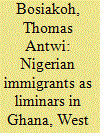

|
|
|
|
|
| Summary/Abstract |
The mobility/immobility research frontier in migration scholarship has gained ascendancy since the beginning of this century with some studies highlighting the need for broader global trends in cross-border mobility/immobility research. This article on Nigerian immigrants as ‘liminars’in Ghana, West Africa, is an attempt to join the global cross-border mobility/immobility discourse on mobile people. It is anchored in the qualitative research tradition with the empirical data generated through in-depth interviews, observations and market conversations with 41 Nigerian immigrant entrepreneurs in Accra (the capital of Ghana), Kumasi (the second largest city after Accra) and Ashaiman (a sprawling sub-urban settlement). In a three-theme analysis approach, the paper shows three intersections in mobilities, immobilities and borderland accounts, namely mobility/borderland, trapped/living in a borderland space, and immobility in temporal-spatial borderland, and places the immigrants into a liminar category. This article is a contribution to understanding the mobility/immobility research frontier from the perspective of the global south and its impact on global southern ‘citizens’.
|
|
|
|
|
|
|
|
|
|
|
|
|
|
|
|
| 15 |
ID:
149750
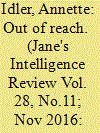

|
|
|
|
|
| Summary/Abstract |
Colombian voters have narrowly rejected a peace deal with the insurgent group FARC. Annette Idler surveys the prospects for security in the country's border regions.
|
|
|
|
|
|
|
|
|
|
|
|
|
|
|
|
| 16 |
ID:
153871


|
|
|
|
|
| Summary/Abstract |
This article looks at smuggling among the Awlad ‘Ali Bedouin in the borderland of Egypt and Libya. Smuggling is understood as a transgressive economic practice that is embedded in the wider social, political and cultural connectivity of the Awlad ‘Ali. This connectivity transgresses state borders, collides with conceptions of state sovereignty, territory and citizenship. In addition, it has a greater historical depth than the respective post-colonial states, and is in many respects more vital than these. During the regimes of Gaddafi and Mubarak the economic productivity and political stability in the borderland was based on the shared sovereignty between politicians and cross border traders of the Awlad ‘Ali and the Egyptian and Libyan state. During and after the Arab spring and particularly in the subsequent civil war in Libya local non state sovereignties that operate across borders have gained significant empowerment and relevance. The article argues that shared sovereignty between state and non-state formations, between centres and peripheries, and between the national and the local level, is a central feature of the real practice of African governance and borderland economies.
|
|
|
|
|
|
|
|
|
|
|
|
|
|
|
|
| 17 |
ID:
185967
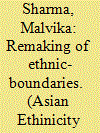

|
|
|
|
|
| Summary/Abstract |
Being an Ethnic-Pahari-Sikh-Borderlander in Poonch, Jammu and Kashmir is a phenomenon that adds to the discourse of ethnicity and nationalism. Partition of the Indian sub-continent in 1947 acted as a disruption in the socio-political history of the ethnic-community of Poonch generating difference and othering. This led to a newer set of challenges that re-imagines the concept of ethnicity altogether. Through an ethnographic account of the religiously assertive Sikh-identity in Poonch, this study asks the questions: Can the religious-reassertion of identities in a community render a concept as giant as ethnicity a myth? What happens to the historic origins of ethnic-bonds when identities begin to organise themselves exclusively on religious lines? Identities in Poonch exist at crossroads where being a religious Sikh challenge the idea of an ethno-geographic Sikh, both of them trying to co-exist under a bigger identity of being a borderlander.
|
|
|
|
|
|
|
|
|
|
|
|
|
|
|
|
| 18 |
ID:
189551
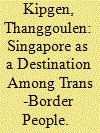

|
|
|
|
|
| Summary/Abstract |
This article analyses the significance of kinship and ethnic networks in the migration of the Kuki people from the Indo-Myanmar borderland to Singapore. In addition to facilitating the dissemination of information and the formation of collective decisions, kinship and ethnic networks are crucial in fostering a sense of community and belonging in the new destination. The article investigates the church’s function among Singapore’s Kuki population. It argues that religion deconstructs ‘otherness’ that came about when colonial rulers split the Kukis into two separate countries (India and Myanmar). The church serves as a powerful symbol of Kuki identity since it facilitates efforts for ethnic unification and allows them to revive the sense of ethnic solidarity lost for decades.
|
|
|
|
|
|
|
|
|
|
|
|
|
|
|
|
| 19 |
ID:
153277


|
|
|
|
|
| Publication |
Oxon, Routledge, 2017.
|
| Description |
x, 258p.hbk
|
| Standard Number |
9781138282896
|
|
|
|
|
|
|
|
|
|
|
|
Copies: C:1/I:0,R:0,Q:0
Circulation
| Accession# | Call# | Current Location | Status | Policy | Location |
| 059129 | 954.9045/GUP 059129 | Main | On Shelf | General | |
|
|
|
|
| 20 |
ID:
154798
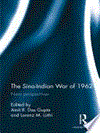

|
|
|
|
|
| Publication |
Oxon, Routledge, 2017.
|
| Description |
x, 258p.hbk
|
| Standard Number |
9781138282896
|
|
|
|
|
|
|
|
|
|
|
|
Copies: C:1/I:0,R:0,Q:0
Circulation
| Accession# | Call# | Current Location | Status | Policy | Location |
| 059160 | 954.9045/GUP 059160 | Main | On Shelf | General | |
|
|
|
|
|
|
|
|
|